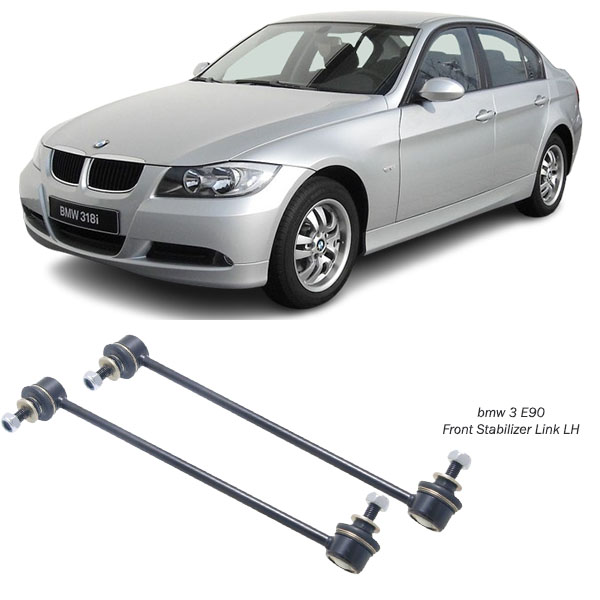-20%
Get BMW 3 E90 Front Stabilizer Link LH 1923-E90FL in Kenya
A stabilizer link, also known as a sway bar link or anti-roll bar link, is a vital component within a vehicle’s suspension system that plays a critical role in improving stability, reducing body roll, and enhancing handling characteristics. It connects the stabilizer bar (sway bar) to the suspension components, such as the control arms or struts, and effectively helps to maintain balance and control during cornering and uneven road conditions. Here, we will delve into the functions, components, types, importance, signs of issues, replacement considerations, and maintenance tips related to stabilizer links.
Functions and Components of Stabilizer Links
- Connecting the Stabilizer Bar: The primary function of a stabilizer link is to connect the stabilizer bar to the suspension system of the vehicle. The stabilizer bar is a metal rod that spans the width of the vehicle and is typically mounted to the chassis or frame. It acts as a torsion spring that resists the rolling motion of the vehicle during cornering.
- Reducing Body Roll: Stabilizer links play a crucial role in reducing body roll, which is the leaning or swaying motion of the vehicle during turns. When the vehicle enters a corner, lateral forces are exerted on the body, causing it to roll towards the outside of the turn. The stabilizer bar, connected by the stabilizer links, counteracts this motion by transferring force from one side of the suspension to the other, thereby stabilizing the vehicle and keeping it more level.
- Enhancing Stability and Control: By minimizing body roll, stabilizer links contribute to enhanced stability and control of the vehicle. This improves overall handling performance, making the vehicle more responsive to steering inputs and reducing the likelihood of oversteer or understeer during cornering maneuvers.
- Absorbing Road Vibrations: Stabilizer links are equipped with bushings and sometimes ball joints, which help to absorb road vibrations and shocks. This not only improves ride comfort by reducing the transmission of bumps and vibrations to the vehicle’s chassis but also helps to maintain stability and traction by keeping the wheels firmly planted on the road surface.
Types of Stabilizer Links
- Fixed vs. Adjustable Links:
- Fixed Links: Fixed stabilizer links have a set length and are typically used in standard suspension setups. They are straightforward to install and maintain but offer limited adjustability.
- Adjustable Links: Adjustable stabilizer links feature a threaded design or turnbuckle mechanism that allows for length adjustment. This flexibility in length makes them suitable for vehicles with modified suspensions or those requiring precise tuning of handling characteristics.
- OEM vs. Aftermarket Links:
- OEM Links: Original equipment manufacturer (OEM) stabilizer links are designed to meet the specifications and quality standards set by the vehicle manufacturer. They ensure compatibility and reliability with the vehicle’s suspension system.
- Aftermarket Links: Aftermarket stabilizer links may offer performance enhancements, such as improved durability or handling characteristics. They come in various materials and designs, including polyurethane bushings for increased stiffness and responsiveness.
Importance of Stabilizer Links
Stabilizer links are essential components of a vehicle’s suspension system for several reasons:
- Improved Safety: By reducing body roll and enhancing stability, stabilizer links contribute to safer driving conditions, especially during high-speed maneuvers and sudden lane changes.
- Enhanced Handling: Properly functioning stabilizer links improve handling precision and responsiveness, allowing for sharper turns and better control of the vehicle’s trajectory.
- Extended Tire Life: By maintaining proper suspension geometry and reducing uneven tire wear, stabilizer links help to extend the lifespan of tires, resulting in cost savings and optimal performance.
Signs of Issues with Stabilizer Links
- Clunking or Rattling Noise: Worn or damaged stabilizer links often produce clunking or rattling noises when driving over bumps or rough surfaces. This indicates loose or worn-out ball joints, bushings, or mounting hardware.
- Uneven Tire Wear: Misaligned or worn stabilizer links can cause uneven tire wear patterns, such as excessive wear on the inner or outer edges of the tires.
- Steering Instability: Excessive play or instability in the steering wheel, particularly during cornering or lane changes, may indicate issues with stabilizer links affecting suspension alignment and responsiveness.
- Visible Damage or Movement: Inspect the stabilizer links for visible signs of damage, such as corrosion, cracks in rubber bushings, or excessive movement in the linkage during vehicle operation.
Replacement Considerations
- Complete Assembly vs. Individual Components: Depending on the condition of the stabilizer links, you may choose to replace the entire assembly or individual components such as bushings, ball joints, or mounting hardware. Complete assembly replacement ensures comprehensive restoration of suspension performance.
- Quality Parts: Use high-quality OEM or aftermarket stabilizer links from reputable manufacturers to ensure proper fitment, durability, and performance. Consider upgrading to adjustable or performance-oriented stabilizer links for enhanced handling characteristics.
- Professional Installation: For complex repairs or if you’re unsure about the process, seek assistance from a qualified mechanic or automotive technician experienced in suspension system repairs to ensure proper installation and alignment.
- Alignment Check: After replacing stabilizer links or making adjustments, perform a wheel alignment to restore proper suspension geometry and optimize handling and tire wear.
Maintenance Tips
- Regular Inspection: Include stabilizer links in routine suspension inspections, checking for signs of wear, movement, or abnormal noise. Address any issues promptly to prevent further damage to suspension components.
- Lubrication and Cleaning: Maintain stabilizer links by lubricating ball joints, bushings, and pivot points as recommended by the manufacturer. This helps prolong component life and ensures smooth operation.
- Avoid Overloading: Avoid overloading your vehicle beyond its recommended capacity, as excessive weight can accelerate wear on suspension components, including stabilizer links.
Follow us on Facebook for more parts.



